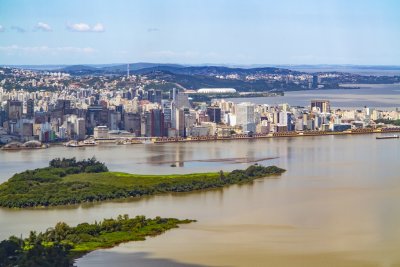Home > South America > Largest lakes
 There are not many large lakes in South America, the major ones are all salt or marshy basins, except Titicaca, located in the Andes at over 3,800 meters high.
There are not many large lakes in South America, the major ones are all salt or marshy basins, except Titicaca, located in the Andes at over 3,800 meters high.However, the southern part of the continent has a region rich in freshwater basins, with numerous lakes between Argentina and Chile.
There are also a good number of seasonal basins, especially in the Amazonian equatorial belt, which in the wettest periods have a much larger surface than in the dry season; in Brazil and also other nations several dams have been built which have created large artificial basins.
| Lake | Area (km²) |
Area (sq mi) |
Country |
| Lagoa dos Patos (1) | 9,850 | 3,803 | Brazil |
| Titicaca (2) | 8,372 | 3,232 | Bolivia, Perù |
| Ciénaga Grande de Santa Marta (3) | 4,280 | 1,653 | Colombia |
| Mar Chiquita (4) | 4,000 | 1,544 | Argentina |
| Laguna Merin | 3,750 | 1,448 | Brazil, Uruguay |
| Lago Buenos Aires (5) | 1,850 | 714 | Argentina, Chile |
| Lago Argentino | 1,466 | 566 | Argentina |
| Viedma | 1,088 | 420 | Argentina |
| San Martín (6) | 1,013 | 391 | Argentina, Chile |
| Lake Poopó (7) | 1,000 | 386 | Bolivia |
| Llanquihue | 860 | 332 | Chile |
| Colhué Huapi | 810 | 313 | Argentina |
* artificial reservoirs are excluded; Lake Maracaibo (13,210 km²) is sometimes referred to as the largest continental lake basin, but it should be considered more correctly as an integral part of the Caribbean Sea, while Lagoa dos Patos is considered to all intents and purposes a lake
(1) Coastal lagoon, connected in the southern part to the Atlantic Ocean by a channel between 1 and 3 kilometers wide.
(2) One of the highest navigable lakes in the world, it is located at 3,812 meters above sea level.
(3) Marshy lagoon separated from the Caribbean Sea by a narrow artificial strip of sand.
(4) Salt lake with a very variable surface area between 2,000 and 6,000 square kilometers depending on the season.
(5) Lake of glacial origin, the largest in the Patagonian region; in Chile it is called General Carrera Lake.
(6) In Chile it is called O'Higgins.
(7) Salt lake that receives a portion of the Titicaca waters via the Desaguadero River.
